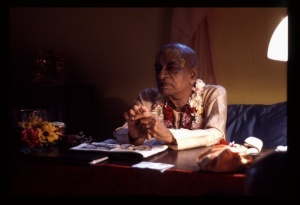CC Madhya 6.178 (1975): Difference between revisions
(Vanibot #0027: CCMirror - Mirror CC's 1996 edition to form a basis for 1975) |
(Vanibot #0020: VersionCompareLinker - added a link to the Version Compare feature) |
||
| Line 2: | Line 2: | ||
<div style="float:left">'''[[Sri Caitanya-caritamrta (1975)|Śrī Caitanya-caritāmṛta (1975)]] - [[CC Madhya (1975)|Madhya-līlā]] - [[CC Madhya 6 (1975)|Chapter 6: The Liberation of Sārvabhauma Bhaṭṭācārya]]'''</div> | <div style="float:left">'''[[Sri Caitanya-caritamrta (1975)|Śrī Caitanya-caritāmṛta (1975)]] - [[CC Madhya (1975)|Madhya-līlā]] - [[CC Madhya 6 (1975)|Chapter 6: The Liberation of Sārvabhauma Bhaṭṭācārya]]'''</div> | ||
<div style="float:right">[[File:Go-previous.png|link=CC Madhya 6.177 (1975)|Madhya-līlā 6.177]] '''[[CC Madhya 6.177 (1975)|Madhya-līlā 6.177]] - [[CC Madhya 6.179 (1975)|Madhya-līlā 6.179]]''' [[File:Go-next.png|link=CC Madhya 6.179 (1975)|Madhya-līlā 6.179]]</div> | <div style="float:right">[[File:Go-previous.png|link=CC Madhya 6.177 (1975)|Madhya-līlā 6.177]] '''[[CC Madhya 6.177 (1975)|Madhya-līlā 6.177]] - [[CC Madhya 6.179 (1975)|Madhya-līlā 6.179]]''' [[File:Go-next.png|link=CC Madhya 6.179 (1975)|Madhya-līlā 6.179]]</div> | ||
{{CompareVersions|CC|Madhya 6.178|CC 1975|CC 1996}} | |||
{{RandomImage}} | {{RandomImage}} | ||
==== TEXT 178 ==== | ==== TEXT 178 ==== | ||
<div class="verse"> | <div class="verse"> | ||
: | :bhagavān--'sambandha', bhakti--'abhidheya' haya | ||
: | :premā--'prayojana', vede tina-vastu kaya | ||
</div> | </div> | ||
| Line 25: | Line 24: | ||
<div class="translation"> | <div class="translation"> | ||
Śrī Caitanya Mahāprabhu continued, | Śrī Caitanya Mahāprabhu continued, "The Supreme Personality of Godhead is the central point of all relationships, acting in devotional service to Him is one's real occupation, and the attainment of love of Godhead is the ultimate goal of life. These three subject matters are described in the Vedic literature. | ||
</div> | </div> | ||
| Line 32: | Line 31: | ||
<div class="purport"> | <div class="purport"> | ||
The Bhagavad-gītā ([[BG 15.15 (1972)15.15]]) also confirms this statement: vedaiś ca sarvair aham eva vedyaḥ. The actual purpose in reading the Vedas is to learn how to become a devotee of the Supreme Lord. The Lord Himself advises, man-manā bhava mad-bhakto mad-yājī māṁ namaskuru (Bg. 9.34). Therefore, after studying the Vedas, one must then execute devotional service by thinking always of the Supreme Lord (man-manā), becoming His devotee, worshiping Him and always offering Him obeisances. This is called viṣṇu-ārādhana, and it is the supreme occupational duty of all human beings. It is properly discharged in the varṇāśrama-dharma system, which divides society into brahmacarya, gṛhastha, vānaprastha, sannyāsa, and brāhmaṇa, kṣatriya, vaiśya and śūdra. This is the whole scheme of Vedic civilization. However, this institution is very difficult to establish in this age; therefore Śrī Caitanya Mahāprabhu advises that we not worry about the Vedic system of varṇāśrama-dharma. Rather, we should take directly to the chanting of the Hare Kṛṣṇa mantra and simply hear about the Supreme Personality of Godhead from pure devotees. This is the process recommended by Śrī Caitanya Mahāprabhu, and this is the purpose for studying the Vedas. | |||
</div> | </div> | ||
Latest revision as of 18:40, 27 January 2020

A.C. Bhaktivedanta Swami Prabhupada
TEXT 178
- bhagavān--'sambandha', bhakti--'abhidheya' haya
- premā--'prayojana', vede tina-vastu kaya
SYNONYMS
bhagavān—the Supreme Personality of Godhead; sambandha—relationship; bhakti—devotional service; abhidheya—transcendental activities; haya—is; premā—love of Godhead; prayojana—the ultimate goal of life; vede—the Vedas; tina-vastu—three subject matters; kaya—describe.
TRANSLATION
Śrī Caitanya Mahāprabhu continued, "The Supreme Personality of Godhead is the central point of all relationships, acting in devotional service to Him is one's real occupation, and the attainment of love of Godhead is the ultimate goal of life. These three subject matters are described in the Vedic literature.
PURPORT
The Bhagavad-gītā (BG 15.15 (1972)15.15) also confirms this statement: vedaiś ca sarvair aham eva vedyaḥ. The actual purpose in reading the Vedas is to learn how to become a devotee of the Supreme Lord. The Lord Himself advises, man-manā bhava mad-bhakto mad-yājī māṁ namaskuru (Bg. 9.34). Therefore, after studying the Vedas, one must then execute devotional service by thinking always of the Supreme Lord (man-manā), becoming His devotee, worshiping Him and always offering Him obeisances. This is called viṣṇu-ārādhana, and it is the supreme occupational duty of all human beings. It is properly discharged in the varṇāśrama-dharma system, which divides society into brahmacarya, gṛhastha, vānaprastha, sannyāsa, and brāhmaṇa, kṣatriya, vaiśya and śūdra. This is the whole scheme of Vedic civilization. However, this institution is very difficult to establish in this age; therefore Śrī Caitanya Mahāprabhu advises that we not worry about the Vedic system of varṇāśrama-dharma. Rather, we should take directly to the chanting of the Hare Kṛṣṇa mantra and simply hear about the Supreme Personality of Godhead from pure devotees. This is the process recommended by Śrī Caitanya Mahāprabhu, and this is the purpose for studying the Vedas.